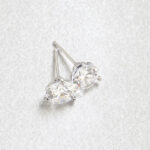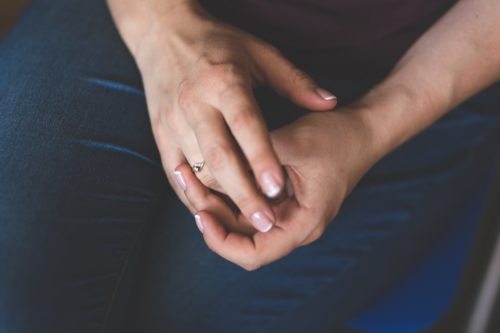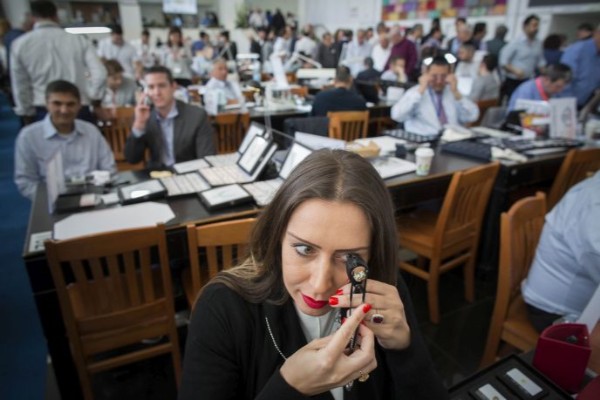
Diamond Stud Earrings: The Complete Guide
August 29, 2019
Where is the Best Place to Buy Wedding Bands?
December 18, 2019A Guide to Chipped Diamonds

A chipped diamond. The words are enough to make any jewelry owners blood run cold. If you have a chipped diamond or are wondering how to prevent a chipped diamond this guide will take you through the do’s and don’ts so that you can wear your jewelry with peace of mind.
View this post on Instagram
Can you Chip a Diamond?
There are a few myths surrounding diamonds and their durability so being clear on the facts will allow you to take the necessary measures to protect your diamond and avoid any disasters. Like any other mineral on earth, a diamond can become chipped and damaged. People often state that a diamond is the hardest substance but it is in fact the hardest mineral. This means that a diamond can be damaged by any other non-mineral substance that is harder.
The hardness of minerals is measure on the Mohs scale and the diamond receives a perfect ten. This means a diamond can scratch anything scoring lower than a ten on the scale (sapphires, emeralds, quartz etc). This is why a diamond is perfect for fine jewelry – it is the hardest and one of the most beautiful minerals around. If it is cut well and looked after correctly, a diamond can last for hundreds or even thousands of years.
How do Diamonds Get Chipped?
Some of the most common causes of diamond damage are lifestyle and activity related. There is a somewhat tricky line between general, everyday wear and high impact activities, and it is this line that leaves many jewelry owners furious at salespeople. A happy bride-to-be may return to a jewelers just a few months after receiving her ring, finding it bent out of shape with chips to the diamond/missing diamond. This ring was supposed to last a lifetime, so surely, she is justified in her disappointment? Well…that depends.
It is true that less reputable jewelers will sell low quality jewelry and hide behind the ‘exerting activities’ clauses. If the bride in question works at an office, removes her ring during exercise etc, then the chances are that this is a badly made diamond ring and the jeweler is at fault. Nonetheless, it is very difficult to prove this so she is unlikely to be offered any solution.
However, even the most expertly crafted engagement rings can be damaged, and even the most beautiful, well-set diamonds can be chipped. If this bride has been lifting weights, gardening or playing sports…if she has granite or marble counter tops in her kitchen that knock against the ring…if she has been climbing or packing and moving boxes, well all of those things would be considered ‘high wear’ activities. In this instance, the jeweler is not at fault.
View this post on Instagram
But if ‘general wear’ clauses weren’t enough to get people impassioned, the other common cause for diamond damage is one that can be even more upsetting. The second danger to your diamond is a jeweler. Prong tightening, polishing and cleaning can all result in diamonds coming loose from their settings or becoming chipped. This can seem like an impossible situation; we know that regular checks and maintenance to your diamond jewelry is crucial in ensuring is longevity, but if there is a risk that the jeweler will cause more damage where does that leave the buyer? Fortunately, I have several tips for keeping your diamond protected.
How to Prevent a Diamond Chipping at the Jewelers
Following these simple steps will help you to prevent heartache during your annual or bi-annual jewelry check-ups:
- Always have an up to date appraisal and make sure your jewelry is insured. A detailed appraisal and a fair insurance policy will be invaluable should the worst happen.
- Sit down with the jeweler and check over your ring An honest jeweler will let you know of any loose diamonds of weak points before carrying out any work. It is good to familiarise yourself with these so that you can check yourself for any issues.
- When you collect your ring, sit down with the jeweler and check it over again using a jewelers loupe. If the diamond has become damaged, the sooner you know about it the better. I have heard horror stories of customers walking out of the store without checking their jewelry and realising weeks later that it is damaged. In these circumstances, it is incredibly difficult to prove that the jewelry store are at fault.
- Consider photographing your diamond and plotting any inclusions or unique details on a piece of paper. Keep a copy for yourself and leave another with a jeweler.
How to Prevent a Diamond Chipping at Home
These steps can be taken at home to keep your diamond protected:
- Remove diamond jewelry during any physical or hands on activity.
- Check that your insurance policy covers accidental damage and read all the small print.
- When you remove your jewelry, place it somewhere safe. Glass trinket dishes may look nice on the bedside table, but fine jewelry is better off return to its box and placed in a safe or locked drawer.
- Clean your jewelry with warm, soapy water and a soft toothbrush, Finish by dipping in a clear alcohol (gin or vodka work fine), rinsing with water and drying with a clean cloth. As well as keep your jewelry sparkling, regular home cleaning means you are more likely to spot any loose claws or scratches.
View this post on Instagram
My Diamond is Chipped. What Should I Do?
If you noticed that your diamond is chipped the first thing to do it immediately remove it and place it somewhere safe. If you continue to wear the diamond you increase the chances of damaging it further.
Following this you have a few options; replace it, re-cut/polish it or hide it.
- If you have checked your insurance policy and replacing the diamond is possible, this is by far the easiest route to take. This option works best for straight forward cases, white diamonds, round brilliant or princess cuts etc but even if your diamond is a little more unusual, with time it will be possible to find a suitable replacement. This approach doesn’t take into account the emotional attachment that we make with our diamonds. If the diamond is inherited or has huge sentimental value, a simple replacement might not feel so simple after all.
- Re-cutting or polishing is really only worthwhile for diamonds of 1.00ct and above. Re-polishing will cause the diamond to lose carat weight. Usually this is a very small amount, around 0.10ct but this is dependant upon the nature of the damage. In some causes you may lose up to 0.30ct removing a chip and even more than that if you are re-cutting to a new shape. There is also a risk that after this process the diamond will no longer fit in its setting. Cutting is fairly costly (upwards of $500) and if a new setting is also required it could be quite an expensive makeover. For many, the heavy costs are outweighed by the emotional significance of the diamond and a desire to see it returned to its sparkling glory. It is essential that you consult with an expert cutter before undertaking this process and that you accept there is a risk that the diamond could shatter while being cut and polished.
- The final option is hiding the chip. I am not a fan of this option as it carries great risk, however as it is being offered more and more its important to take a look at it. We know that settings can hide internal inclusions and so some jewelers will apply the same principle to external damage. Chips or cracks running from the edge of the diamond to the table can be hidden with lengthy, antique style prongs. Chips around the edge of the diamond can be disguised in a bezel setting. There are a number of ways you can hide the damage and the jewelers often use solder to hold everything in place. I feel this is only ever a temporary solution. From the moment a diamond has sustained damage, it is weakened and the likelihood of shattering increases with every small knock or bump.
The Final Word
Prevention is better than cure. Choosing a diamond without risky inclusions is the first step. Regular home care and jewelers check-ups will allow you to spot any potential issues early on. Reducing damage to your ring by removing it during activities will make a huge difference to how long it lasts.
Freak accidents do happen. Sadly, there is no rule about how long you can wear a diamond before it gets chipped – some people will heavy-wear their jewelry for decades without any issues, while other unfortunate people will walk out of the jewelry store, knock their ring on a lamppost and chip the diamond. Following the steps in this guide should give you the freedom to wear your jewelry and enjoy it – that’s what it was made for! A good insurance policy will also put your mind at rest in case the unthinkable should happen.


